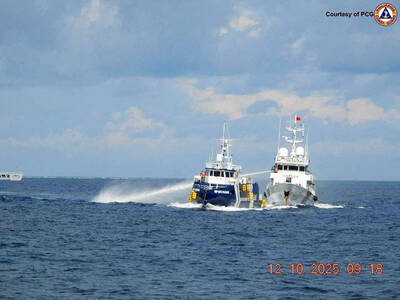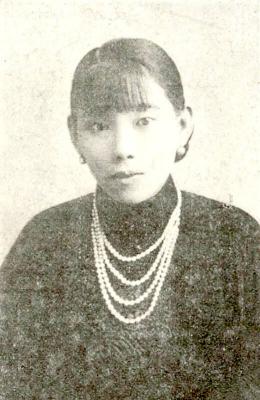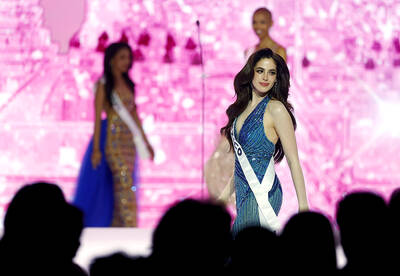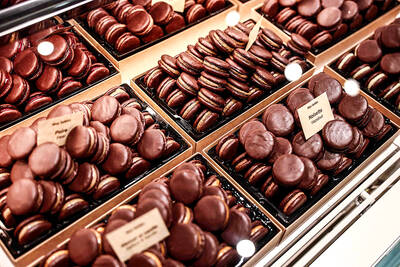Afloating plastic bubble, so hi-tech it is lighter than air, is attached by ropes to the walls of the National Gallery of Denmark in Copenhagen. As I step gingerly on to its see-through floor, I can peer down at the gallery 30m below. When I’m joined by one of the museum staff, I become unsteady. We crawl around this airborne plastic yurt like babies and then, feeling giddy, stop to sit and talk about how our children might end up living in a city of such bubbles, sealed off from a contaminated Earth; about who might be lucky enough to have such a refuge; how they might sing their children lullabies of a lost Earth. It’s an eerie conversation to have with a stranger, both of us imagining a deeply tragic future that seems highly plausible.
This installation, by Argentinean architect-artist Tomas Saraceno, is the biggest in Rethink, a series of contemporary art exhibitions taking place across Copenhagen ahead of tomorrow’s climate change summit. When I tell Saraceno of my experience in his bubble, he is delighted. “Perfect,” he laughs. This, he says, is the role art has to play in tackling climate change. “Art is about trying to rethink the things you take for granted.”
Saraceno is one of several artists appearing at Copenhagen and in the Royal Academy’s Earth: Art of a Changing World show, which opened in London on Thursday. Some activists have wondered why the art world has been slow to grasp the significance of climate change, so you could argue that these exhibitions represent a dramatic awakening. Curators on both sides of the North Sea say the response from artists has been so enthusiastic that they could have filled their spaces twice over. And both report unusually enthusiastic support from governments: the UK Department of Energy and Climate Change has paid for a free guide for every visitor to Earth. It’s as if politicians, recognizing the limits of their ability to engage the public on this issue, are turning in desperation to other means of communicating the enormity of what is at stake. “I didn’t want penguins or icebergs,” says Kathleen Soriano, one of the Earth show’s curators. “There’s nothing literal. We’re not offering information — if visitors want that, we have a Web site. We wanted people to have an aesthetic response.”
That emphasis is evident, but with the beauty comes a sinister undertow. In Copenhagen, Acid Rain, by Bright Ugochukwu Eke, consists of 6,000 hanging plastic bags. They sparkle, gray, clear and black, like Christmas decorations, but they contain carbon dust — currently choking the inhabitants of the delta region of Nigeria, an area of massive oil exploration. At first glance, the work of the Chinese artist Yao Lu (姚璐) appears to be an idealized landscape of mountains and clouds, but look more closely and you’ll see that it’s an urban waste dump.
Gary Hume’s work, The Industrialist, is a lead tracing of a factory chimney billowing smoke. He calls it an epitaph for industrialists, but admits he finds the brief a challenge. “How do you depict global catastrophe?” he says. “I’m too selfish to describe the world’s dilemma, so I describe my own paltry dilemma of what it’s like to be alive.”
Hume describes his involvement with Cape Farewell — an initiative to bring artists and scientists together, in Hume’s case on a trip to the Arctic — as “completely beautiful, [but] hard to relate to my life.” He recycles, grows vegetables, has made his house fuel-efficient, but acknowledges painful contradictions. “The people who do the most damage [environmentally] buy my work, and I’m not using ecologically sound paint. I feel like apologizing — I can’t help the world. Climate change is too big for my art. My painting is a small thing, like a child might do.” Hume talks of the possibility of millions dying, but he is wary of visual art’s long-held fascination with apocalypse. Nature’s indifference to human survival has left him with no grand ambitions — only a modest, if deeply uncomfortable, determination to offer “solace.”
Keith Tyson echoes this notion of humility. Nature Painting, an intense work on show in Earth, was made by mixing toxic chemicals with pigment, echoing natural forms such as cell formations. “Nature has an intelligence far greater than us,” Tyson says. “We talk about saving the Earth, but we’re really talking about saving ourselves. The Earth can look after itself.” Tyson attended a lecture on climate change at Cern, the European Organization for Nuclear Research and home of the Hadron Collider: “It was a scientist talking to other scientists and it was horrific — far worse than people imagine. Terrifying.”
The experience clarified his sense of the artist’s role. “It is not to advocate solutions. It is something much deeper and more subtle — to make us reflect and rethink what it is to be a human being in the 21st century. We don’t have that much power. It’s nature that creates us. That’s the kind of education too subtle to put on a syllabus: that’s the important role of art.”
Curator Soriano was aware of these competing perspectives when she put Earth together. “I didn’t want to be preachy,” she says, and is nervous of any suggestion that the exhibition is the most political the Royal Academy has mounted. In fact, says Anne Sophie Witzke, Rethink’s project manager, the galleries involved in Copenhagen have been cautious: no one wants to be accused of propaganda.
This timidity is a source of frustration for the arts group Platform, which for over 20 years has worked to marry art and activism. “The arts stumble along the fault line between representation and transformation,” says the organization’s James Marriott. “But, until 50 or so years ago, all art was about transformation and persuasion. Look at Goya: he wanted to persuade you of the horrors of war.”
Art, Marriott thinks, is rediscovering a sense of purpose. In the last 50 days, Platform has curated 100 events at the Arnolfini Centre in Bristol, England; many of the featured artists will be joining activists in Copenhagen during the summit.
Marriott is delighted that climate change is finally attracting the attention it needs. “The more the merrier,” he says, rejecting the criticism that artists are climbing on a green bandwagon. He is scathing, however, of the continuing blindness of artists, curators and institutions to their own enormous carbon footprints. “They lug lumps of wood around the world for exhibitions. Printing a catalogue on recycled paper is pathetic tokenism — no FTSE company would get away with that.” Contemporary art is an expensive, global business. Artists, curators and the works all end up flying, while galleries themselves require expensive climactic conditions. Indeed, curators in London and Copenhagen admit they have no idea of the carbon cost of their exhibitions.
Charlie Kronick is the senior climate change adviser at Greenpeace. “The real role is not about using artists to leverage our message up the agenda,” he says, “but for the artist to make this agenda their own. It is important they maintain their authenticity.” Campaign initiatives have made a big impact on a number of artists (Ian McEwan and Antony Gormley have spoken enthusiastically about their Cape Farewell experiences), but many, such as Cornelia Parker, feel daunted by the need to respond to something so huge.
“I try to do my bit,” says Parker, “as a citizen, an artist and in my everyday life.” She has cut down on flying and offsets the flights she takes. But she confesses that her piece for the Earth show, Heart of Darkness, carbon fragments of a forest fire, was not originally about climate change; she was thinking of Al Gore’s election loss and the hanging chads scandal. Now it is being co-opted into the climate change narrative. Similarly, Field, by Gormley, takes on a new meaning here: the frightened, gormless crowds of humans spill out of their room at the Royal Academy, not knowing where to go.
Parker’s work has long had a preoccupation with the apocalyptic, but it was while listening to scientists recount their struggle to communicate the scale of climate change to politicians that she realized art had a vital role to play. She describes this as “a call to arms,” but isn’t keen to be associated with a single issue. She says she has done only one piece of work — a filmed interview with Noam Chomsky, showing in Copenhagen — that deals with climate change, and even then the interview covers a range of issues.
“It was intentionally propagandist,” she says, adding hesitantly that perhaps this is what is required. “After all, the first world war artists were recruited to help fight the war — and this is the equivalent of war.”

Many people noticed the flood of pro-China propaganda across a number of venues in recent weeks that looks like a coordinated assault on US Taiwan policy. It does look like an effort intended to influence the US before the meeting between US President Donald Trump and Chinese dictator Xi Jinping (習近平) over the weekend. Jennifer Kavanagh’s piece in the New York Times in September appears to be the opening strike of the current campaign. She followed up last week in the Lowy Interpreter, blaming the US for causing the PRC to escalate in the Philippines and Taiwan, saying that as

Nov. 3 to Nov. 9 In 1925, 18-year-old Huang Chin-chuan (黃金川) penned the following words: “When will the day of women’s equal rights arrive, so that my talents won’t drift away in the eastern stream?” These were the closing lines to her poem “Female Student” (女學生), which expressed her unwillingness to be confined to traditional female roles and her desire to study and explore the world. Born to a wealthy family on Nov. 5, 1907, Huang was able to study in Japan — a rare privilege for women in her time — and even made a name for herself in the

This year’s Miss Universe in Thailand has been marred by ugly drama, with allegations of an insult to a beauty queen’s intellect, a walkout by pageant contestants and a tearful tantrum by the host. More than 120 women from across the world have gathered in Thailand, vying to be crowned Miss Universe in a contest considered one of the “big four” of global beauty pageants. But the runup has been dominated by the off-stage antics of the coiffed contestants and their Thai hosts, escalating into a feminist firestorm drawing the attention of Mexico’s president. On Tuesday, Mexican delegate Fatima Bosch staged a

Would you eat lab-grown chocolate? I requested a sample from California Cultured, a Sacramento-based company. Its chocolate, not yet commercially available, is made with techniques that have previously been used to synthesize other bioactive products like certain plant-derived pharmaceuticals for commercial sale. A few days later, it arrives. The morsel, barely bigger than a coffee bean, is supposed to be the flavor equivalent of a 70 percent to 80 percent dark chocolate. I tear open its sealed packet and a chocolatey aroma escapes — so far, so good. I pop it in my mouth. Slightly waxy and distinctly bitter, it boasts those bright,